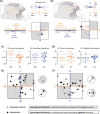Quantitative spatial analysis reveals that the local axons of lamina I projection neurons and interneurons exhibit distributions that predict distinct roles in spinal sensory processing
- PMID: 36094014
- PMCID: PMC9826435
- DOI: 10.1002/cne.25413
Quantitative spatial analysis reveals that the local axons of lamina I projection neurons and interneurons exhibit distributions that predict distinct roles in spinal sensory processing
Abstract
Our knowledge about the detailed wiring of neuronal circuits in the spinal dorsal horn (DH), where initial sensory processing takes place, is still very sparse. While a substantial amount of data is available on the somatodendritic morphology of DH neurons, the laminar and segmental distribution patterns and consequential function of individual axons are much less characterized. In the present study, we fully reconstructed the axonal and dendritic processes of 10 projection neurons (PNs) and 15 interneurons (INs) in lamina I of the rat, to reveal quantitative differences in their distribution. We also performed whole-cell patch-clamp recordings to test the predicted function of certain axon collaterals. In line with our earlier qualitative description, we found that lamina I INs in the lateral aspect of the superficial DH send axon collaterals toward the medial part and occupy mostly laminae I-III, providing anatomical basis for a lateromedial flow of information within the DH. Local axon collaterals of PNs were more extensively distributed including dorsal commissural axon collaterals that might refer to those reported earlier linking the lateral aspect of the left and right DHs. PN collaterals dominated the dorsolateral funiculus and laminae IV-VI, suggesting propriospinal and ventral connections. Indeed, patch-clamp recordings confirmed the existence of a dorsoventral excitatory drive upon activation of neurokinin-1 receptors that, although being expressed in various lamina I neurons, are specifically enriched in PNs. In summary, lamina I PNs and INs have almost identical dendritic input fields, while their segmental axon collateral distribution patterns are distinct. INs, whose somata reside in lamina I, establish local connections, may show asymmetry, and contribute to bridging the medial and lateral halves of the DH. PNs, on the other hand, preferably relay their integrated dendritic input to deeper laminae of the spinal gray matter where it might be linked to other ascending pathways or the premotor network, resulting in a putative direct contribution to the nociceptive withdrawal reflex.
Keywords: dorsoventral excitatory drive; laminar axon density; mediolateral asymmetry; quantitative analysis; withdrawal reflex.
© 2022 The Authors. The Journal of Comparative Neurology published by Wiley Periodicals LLC.
Conflict of interest statement
The authors declare no conflict of interest.
Figures







References
Publication types
MeSH terms
Substances
Grants and funding
- POCI-01-0145-FEDER-016588/FEDER-Fundo Europeu de Desenvolvimento Regional funds through the COMPETE 2020-Operacional Programme for Competitiveness and Internationalization (POCI), Portugal 2020
- KTIA_NAP_13-2-2014-0005/Hungarian Brain Research Program
- 2017-1.2.1-NKP-2017-00002/Hungarian Brain Research Program
- Marie-Curie Short Term Fellowship
- Graduate School of Pain (EURIDOL)
- ANR-17-EURE-022/French National Research Agency - ANR
- PTDC/NEU-NMC/1259/2014/FCT-Fundação para a Ciência e a Tecnologia/Ministério da Ciência, Tecnologia e Ensino Superior
- SFRH/BPD/120097/2016/FCT-Fundação para a Ciência e a Tecnologia/Ministério da Ciência, Tecnologia e Ensino Superior
- SFRH/BD/118129/2016/FCT-Fundação para a Ciência e a Tecnologia/Ministério da Ciência, Tecnologia e Ensino Superior
LinkOut - more resources
Full Text Sources

